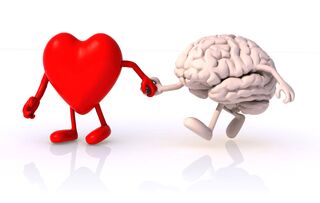Vagus Nerve
Why Body, Heart, and Mind Are So Important for Well-Being
The interconnection between bodily awareness, vagal nerve, and the mind.
Posted August 6, 2020

Accounts of body and mind dating back to the 16th century by philosopher René Descartes suggested that there was some kind of duality between these1. Descartes and others at the time suggested that information was sent from the brain to organs only, and that the organs and heart had little influence over mental health, well-being, or any other behavioral decisions. This is called the Cartesian position (relating to the beliefs of Descartes), and has perhaps been the dominant view for centuries. However, recent studies that have come to light have demonstrated that the body affects the mind via the signals being transmitted through neurons called afferent nerve fibers, which travel and send instructions from the body to the brain, which then help form homeostatic, as well as emotional, cognitive and behavioral responses to the various incoming environmental and bodily stimuli.
So, it is clear today that these more recent findings demonstrate that Descartes was wrong, and that our internal body and heart output information to the brain, which actually influences our thoughts, feelings, and behaviors, and perhaps even helps make up our conscious representation of ourselves (something called meta-representation)—and this process is called the interoceptive pathway. By using a device that records heartbeat signals electronically, called an electrocardiogram (ECG), to record the heart-beat evoked potential that interoceptive states can be recorded and studied.
Another anatomical structure that is important for linking the body and mind is called vagal nerve, and is the 10th cranial nerve that transmits signals to the brain from the heart and vice versa. Vagal nerve signaling to and from the heart can also be recorded by the ECG, and this measure is called heart rate variability (HRV), which measures the variation between each consecutive heartbeat peak (called R-R peaks). The HRV can measure whether the body is in a state parasympathetic (relaxed) or sympathetic (stressed or excited) activity, and the heart sends signals to the brain circuits, which is involved with important emotional regulation functions2. Indeed, low HRV is associated with psychological disorders such as depression and anxiety3, whereas high, more variable, HRV is associated with positive well-being and mental health.
In addition to emotional regulation, interoception and HRV have been found to be associated with behavioral regulation coping strategies. In my own lab, we recently conducted a review that explored such associations and found that there were clear relations between interoception, HRV and emotional regulation as well as emotional regulation strategies.
Emotional regulation strategies can be categorized as either antecedent-focused or response-focused. Antecedent are generally more adaptive strategies, as they typically provide better emotional and physiological regulation with minimal mental (cognitive) expenditure4. Emotional reappraisal is one example of an antecedent strategy, which is an attempt to reframe an event (such as thoughts) to reduce its negative impact, and this is consistent with the approach of mental health therapeutic approaches such as cognitive behavioral therapy (CBT) or, in the case of changing our relationships to our thoughts, acceptance and commitment therapy (ACT)5.
On the other hand, response-focused strategies, such as using drugs or alcohol to reduce the painful emotion, or thought suppression to squash the thoughts (i.e., telling yourself not to think of the bad thoughts), are often counterproductive, use enormous mental effort, and can actually lead to an increase in such negative thoughts and associated negative feelings. A simple and convincing way to demonstrate to you that thought suppression is not a good way to stop unwanted thoughts is if I asked you to not think of a "pink elephant." You would immediately think of a pink elephant and would be completely powerless to stop it. The same thing applies if we try to stop painful unwanted thoughts, so this type of suppressive coping strategy is entirely futile.
Instead, therapeutic approaches such as ACT ask people to change their relationship with their thoughts instead of changing their thoughts, and this is done through a process of openness and acceptance to pain. ACT exercises would also encourage the client to focus their attention on the moment, not to try to alter any of their thoughts, not to judge them, and to simply watch them come and go. This kind of antecedent emotional regulation strategy has been shown to be extremely helpful for the management of complex, mental health issues such as anxiety and depression.
There is a clear link between the antecedent ACT-based coping strategies and vagal responses such as HRV and interoceptive processes, which may play key roles in psychological components of psychological flexibility. By targetting mental and bodily processes, we may be able to maximize the effectiveness of our existing mental health therapies and explore ways in which we humans adapt to environmental stimuli to form the society in which we live.
References
1. Damasio. (2006). Descartes' error: Random House.
2. Mather, M., & Thayer, J. F. (2018). How heart rate variability affects emotion regulation brain networks. Current opinion in behavioral sciences, 19, 98-104.
3. Brunoni, A. R., Kemp, A. H., Dantas, E. M., Goulart, A. C., Nunes, M. A., Boggio, P. S., . . . Benseñor, I. M. (2013). Heart rate variability is a trait marker of major depressive disorder: evidence from the sertraline vs. electric current therapy to treat depression clinical study. International Journal of Neuropsychopharmacology, 16(9), 1937-1949.
4. Ochsner, K. N., & Gross, J. J. (2005). The cognitive control of emotion. Trends in cognitive sciences, 9(5), 242-249
5. Hayes, S. C., Strosahl, K. D., & Wilson, K. G. (2009). Acceptance and commitment therapy: American Psychological Association Washington, DC:.


